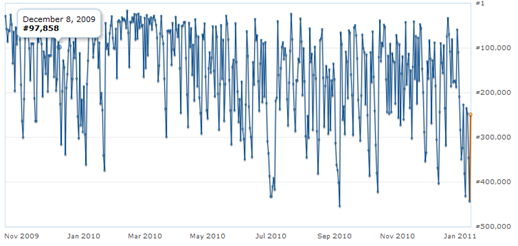I’m sitting in a hotel room in Munich. I’m slightly jet lagged (I’ll recover by tomorrow), but feeling better than I’ve felt in a week. I’m feeling so good, in fact that I have an abundance of "things" I feel like writing about.
If you don’t want to read a non-testing related post (or partially related at best), go ahead and skip this post – and maybe even the next one. I’m not sure where it’s going, but if I don’t start dumping these random thoughts out of my head, I may never get them out.
I’ll back up to last Sunday. My slides for the STP webinar (recording here, slides here) were due the previous Friday, but my rockin’ day-job was taking up a ton of my time, and all I had was an outline. You should note, that while this post isn’t about how to make a presentation, how to put together slides, or even procrastination for that matter, a good outline is the core of a good presentation. If you have an outline and notes that cover your main points, /and that tell a story/, putting the slides together isn’t much more than busy work. I could relate this to a story about arranging My Favorite Things for studio orchestra, but I’ll save that for another day.
I played soccer Sunday afternoon and had a pretty good game. After the game, I headed into work (my wonderful wife knows that if I need to crank out work, my work office on the weekend is the place to be. It’s quiet, it has a comfortable chair and large monitors). I arrived at the office around 6:30 (most buildings at MS have showers, so I was able to freshen up), and finished up the slides just before 9:00. I was tweaking, poking, adding, deleting and a bunch of other stuff I shouldn’t have been doing after a two hour slide session, but common sense prevailed and I decided it was time to head home. I saved the slides, then I reached into my gym bag to have another drink of gatorade before leaving. On a side note, I can’t prove this, but I’m 99% positive that the gatorade we drink today is absolutely nothing like what I drank when I was a kid. Now, I know that it came from powder, and we mixed it with water, but the stuff today is way to sweet for me.
So anyway…as I took the last swallow, I noticed a tiny little tickle in my throat. I’ve had the same tickle many times before, and it almost always means that some sort of cold his heading my way.
The next morning I woke up with a painful sore throat, but other than that I felt fine. I went to work, polished up the slides and sent them off to STP, then went through the rest of my typical work day. Tuesday, I still had the sore throat, but was feeling pretty run down too. I had a big chunk of stuff to do, so I made it through half a day then headed home for "a nap".
I went to bed Tuesday afternoon around 3:00, and didn’t /really/ get out of bed until Thursday morning. I was in bed so long that I had to get up and walk just to relieve the back pain from sleeping so much. I’d wake up from time to time thinking "I must be better by now". I’d sit and read while waiting to see if I felt strength returning. One time I was so "strong" that I could stay awake for almost 45 minutes before sliding back under the covers and drifting off again.
I’ve had many sore throats in my life (I got strep several times when I was a kid), but this one was special. Take a moment and swallow right now. Pay attention to the way the muscles in your throat contract, touch, and open as you swallow. Now, imagine that while you were sleeping, someone grafted a piece of sharp granite to your right tonsil (if you don’t have tonsils, imagine they wedged it into the hole where that tonsil used to be). Now, every time when you swallow, this piece of granite cuts into your throat. I’ve never wanted to not-swallow more in my life.
By Thursday morning, I felt well enough to take some cold medicine and go give a webinar (luckily I was muted when I started singing a medley of Colin Blunstone hits). I had a few other meetings to get through on Thursday (these things happen when you’re about to leave the country for nearly a week), but made it home by 3:30, took a nap (only 2 hours this time), had dinner, packed, then went back to bed.
I was still feeling out of it Friday morning, but could tell I was on the way back to normal. As of today (Sunday morning in Munich), I feel pretty good and should be 100% by tomorrow.

